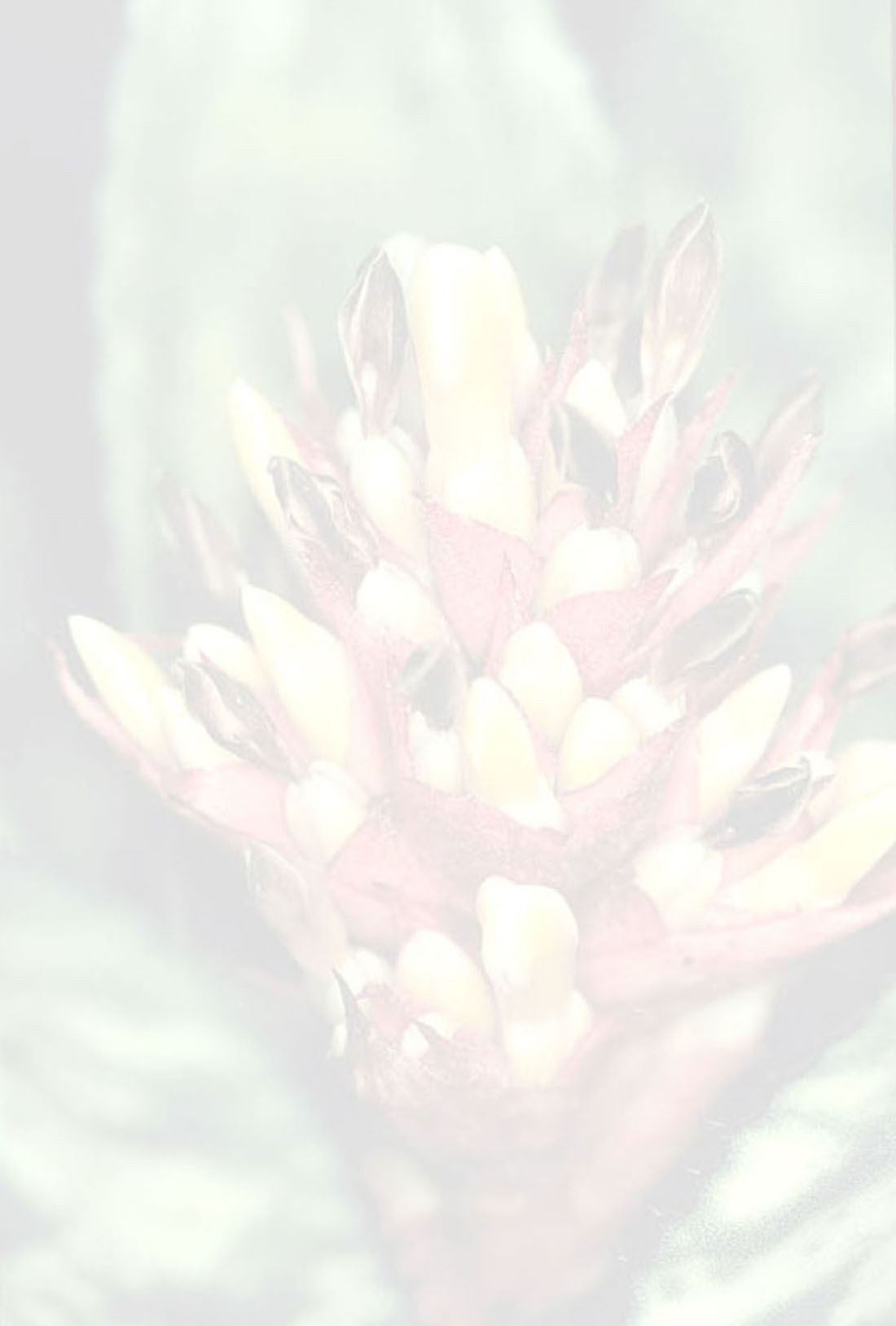

 Aechmea itapoana Morawetz, W. & Till, W.[as Aechmea itapoana W. Till & R Morawetz]
Aechmea itapoana Morawetz, W. & Till, W.[as Aechmea itapoana W. Till & R Morawetz]Diagnose: —Planta terrestris, 0.6-1 m alta ; folia in rosulam anguste-infundibuliformam erectam collocata. Vagina foliorum obsoleta, ca, 20cm longa et 17 cm lata; lamina lingulata, apice longe (9 mm) cuspidata, margine minute serrata, viridis vel argenteo-lepidota.Scapus erectus paucibracteatus, folia manifeste superans. Inflorescentia composita, terminalis; spicae 2-4, strobiliformes, dense ± distichae, sessiles, 6-9 cm x 3 cm. Bracteae spicarum longe anguste triangulares, acuminatae, multinerves, appresse lepidotae, 1/3-1/2 spicarum aequantia. Bracteae florum sepala aequantes, oblongo-ovatae et spinoso-acuminatae, multinerves, appresse vel puberulo-lepidotae, margine saepe serratiusculae, calycem cingentes. Calyx cum gynoecio 18 mm longus. Sepala asymmetrica libera, 12 mm x 6 mm, triangulato-acuminata, manifeste carinata, margine integerrima, saepe lanuginoso-lepidota. Petala basi exappendiculata. Fructus sive color floris ignoti. Habitat in campis arenosis maritimis et locis apertis thiniorum prope Itapoa, provinciae Bahia, Brasilia boreo-orientalis. Observations: —Note: The type material consists only of inflorescences, the paratype only of leaves. Both come from the same population and are mounted in pairs on single sheets.
The new species appears to be an ± isolated member within the subgenus Chevaliera (Gaudichaud ex Beer) Baker which is characterized by the absence of petal appendages. It is easily recognized by its long, characteristically aggregated leaves (Figs. la, 2), its distinctly larger scape and compound inflorescence with strobiliformous, ± distichously arranged spikes (Fig. lb).
Possibly, A. itapoana is related to A. multiflora L. B. SMITH from Bahia, the latter differing in its numerous, scape-concealing scape bracts (fewer and smaller in A. itapoana) and in its simple inflorescence. A. itapoana could be related to the epiphytic A. rodriguesia (L. B. Smith) L. B. Smith from Manaus, if one considers the often entire margined, basal floral bracts of the new species. However, the latter differs in having broadly triangular leaves with distinct sheaths (A. itapoana has tongue shaped leaves with hardly recognizable sheaths), broadly ovate primary bracts (not narrowly triangular), and the fewer flowered globosely arranged spikes (not distichous).
The subgenus Chevaliera has two distribution centres: One from the Guyanas to Central America and Andine Columbia, and the other in Eastern Brazil (Smith & Downs 1979). The latter includes mostly terrestrial members, e.g. A. itapoana and the quite different A. muricata (A. deCamara) L. B. Smith which occurs in Pernambuco in a similar habitat. Other terrestrial species, also frequent in open coastal vegetation types, belong to different subgenera, e.g. A. pineliana (Brongniart ex Planchon) Baker from Rio de Janeiro to Espirito Santo (Ule 1901), the Bahian taxa A. blanchetiana (Baker) L. B. Smith, A. lamarchei Mez and A. lingulata (L.) Baker var. froesii L. B. Smith (Harley & Mayo 1980).
Ecology. Within the study area A. itapoana occurs most frequently in the dunes at a distance of about 0,5-5 km from the shore. There it is confined mainly to the margins of xeric scrub and woodland (Fig. 2) with an irregular but dense distribution pattern. Important physiognomic characteristics of this vegetation type are the low trees and bushes (up to 5-6m) with smooth bark, and frequent vegetative propagation, small xeromorphic or semisucculent leaves, and well-developed, sometimes 5 m long root systems. Furthermore, vines, terrestrial Orchidaceae and Cactaceae are common, while epiphytes lack. Some dominant tree species are the low palm Allagoptera arenaria
(Gomes) O. Kuntze (often in a marginal position like A. itapoana) Coccoloba sp., Guettarda platypoda DC., Humiria balsamifera (Aubl. ) St. H., Hyptis blanchetii Benth., Kielmeyera argentea Choisy, K. reticulata Saddi, Leucothoe revoluta DC. and Manilkara sp. In addition, A. itapoana also forms part of the early succession together with the very low and open scrub with a succulent leafless Euphorbia sp., Krameria sp., Stylosanthes viscosa Sw., Vellozia cf. glochidea Pohl, a succulent Melastomataceae, diverse Cyperaceae and Eriocaulaceae (e.g. Paepalanthus sp.). This vegetation type will be described in greater detail in a subsequent paper (Morawetz 1981).Edited from (30-12-2014): Till & Vitek 1985. (protologue) Tillandsia marconae - eine neue Art aus der peruanischen Küstenwüste .